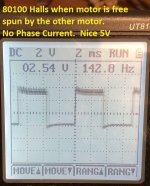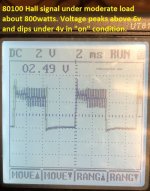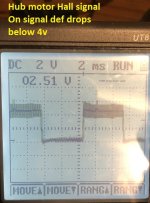Quickie post...
I for whatever reason never posted about actually making up a hall harness for a motor. I commonly build the hall harness in the motor, but I also do it this way too.
I used teflon wire so it can hold up to whatever heat is happening in the motor. I used real SS41F halls bought from Mouser, NOT chinesium halls bought on ebay. Reliability is key here and the chinesium ones may or may not last. Also, getting halls that actually work is sometimes hit and miss. It's better to just buy legit halls from a legit source. I've tested chinese halls, installed them in a motor and a few days later they go bad. GRRR! Yes they cost 1/20 the money, but there is really good reasons for this!
The first thing I did was cut sections of the smallest size heat shrink I had in red, black and yellow. They are about 1/8" shorter than the length of the hall legs. I shrink these sections down and this makes them just about the right size to slide over the hall legs. I now have via color the leg pinouts. Red is +5v, black is ground and yellow is signal. There's no point cutting yellow blue and green heat shrink for the signal leg since I have no idea at this point which hall is which. Also the actual color of the signal wire is irrelevant. They will go into the motor 120 degrees apart and ONLY after you try out the halls with the phases do the three signal colors actually matter in any way.
I tinned the ends of the hall legs and the wire ends that will solder to them. This makes solder flow virtually guaranteed between the leg and the wire end. I cut 4 lengths of red and black at about 3" long. These will go to 2 of the 3 halls. The third hall will get red and black soldered to it that are long enough to exit the motor. At 3" from the hall, I strip off a short section of the insulation form these 2 longer wires and solder on the red and black wires from the other 2 halls.
Once all 3 wires are soldered to a hall, I then slide heat shrink over the solder connections and over the heat shrink already on the legs. Chances of a short are virtually impossible. I then use a slightly larger diameter piece of heat shrink over the hall and part way down the legs. This keeps the hall legs from bending and flexing independently so they won't break from vibration in the motor.
All electrical connections get covered in heat shrink.
I didn't show it in this image, but I also color the face of the hall so when installing them I don't put them in backwards. When done all wires are cut to the same length and the 5 ends tinned. I left about 12" of length. This will be more than enough to get the wires out of the motor with lots of extra length too.























